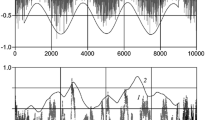Abstract
A solution of the problem of correlation analysis of stochastic amplitude-angle modulated signals is presented. The solution is obtained on the basis of the theory of linear stochastic processes for the general case of nonstationary correlated Gaussian noises in both modulation channels. These noises are regarded as the results of a linear filtration of Gaussian white noise processes. As an example of the analysis a case of band-pass modulation noises is considered.
Similar content being viewed by others
References
K. Ito, Stationary random distribution,Mem. Coll. Univ. Kyoto 28 (1954), 209–223.
B. G. Martchenko,Methods of Stochastic Integral Representations and its Applications in Radio-Engineering (in Russian), 191 pages, “Naukova Dumka”, Kiev (1973).
A. Papoulis, Random modulation: A review,IEEE Trans. on Acoustics, Speech, and Signal Processing, vol. ASSP-31, no. 1, February (1983).
Author information
Authors and Affiliations
Rights and permissions
About this article
Cite this article
Malyarenko, A.P., Martchenko, B.G. Correlation analysis of stochastic amplitude-angle modulated signals. Circuits Systems and Signal Process 15, 335–342 (1996). https://doi.org/10.1007/BF01182590
Received:
Accepted:
Issue Date:
DOI: https://doi.org/10.1007/BF01182590



